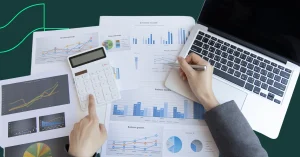Behind the Innovation – An R&D project on fractional ownership
22 February 2024

Real estate, like many other industries currently, is undergoing further digitalisation and this is visible through the emergence of PropTech, a market that is predicted to reach $133.05 billion by 2032. PropTech is removing paper and clunky processes through technology-powered innovation. Our client, Technical Methods, had a standout successful R&D claim in their fractional ownership project using machine learning and blockchain smart contracts. It was an eye-opening experience completing their R&D claim on their behalf because it showed us the upward trajectory of efficiency in real estate that we can continue to expect. Let’s explore how this innovation came about and the impact it has had.
Introducing the R&D project for fractional home ownership
The mission of Technical Methods Limited was to simplify and streamline the opportunity of fractional ownership through a compliant blockchain platform with smart contracts, helping investors in real estate. They wanted their platform to reduce operational costs and time involved in real estate transactions while ensuring no legal issues arise within their smart contracts.
They acknowledge that this technology has been used for various use cases. Still, so far there has not been a solution that implemented blockchain technology and smart contracts to enhance the transparency, security, and efficiency in property investment, specific to fractional ownership investment opportunities. To achieve their mission, they needed to carry out research and development for:
- Investigating existing blockchain solutions in the real estate industry and studying the vulnerability to identify the benchmark.
- Set up a blockchain infrastructure, configuring it to their requirements.
- Design and code smart contracts for property transactions, ownership management, and dispute resolution.
- Collaborate with legal experts to ensure smart contracts adhere to regulatory standards and address legal issues effectively.
- Explore machine learning-based techniques to enhance the security of smart contracts and conduct thorough testing.
These steps took a considerable amount of time and came at a cost they could claim for as part of their R&D tax credit claim.
What is fractional ownership?
Fractional ownership involves multiple individuals sharing ownership of an asset. While we’re talking in the context of real estate, it can also be used for other assets such as aircraft or artwork. Each co-owner holds a portion of the asset, typically represented by shares, and they collectively make decisions regarding its use, maintenance, and potential sale. For example, if you are one of 100 property owners, you can access 100x higher-value and institutional grad assets without bearing the full financial burden.
What were the main challenges of building the fractional ownership solution?
Like all R&D projects, the number one challenge was attempting to generate a solution without existing literature providing the answers or guiding the team on where to start to complete their project. It involved some trial and error and in-depth research on how to meet the needs of prospective fractional ownership investors.
Specific challenges that arose were trying to find a way to combine blockchain and smart contracts because this has not been done before for fractional ownership. Their platform needed to be capable of handling asset acquisition, company formation, and transactions, all within a single operation that meets compliance requirements as they evolve. There were also code issues that affected smart contract performance that needed time to solve.
What did this R&D project achieve?
Throughout the claiming year of Technical Methods, their R&D project on fractional ownership achieved:
- A novel integration of processes for efficiency – The platform held all the essential processes for fractional ownership such as the transactions and asset acquisition with full transparency, compliance, and efficiency.
- Enhanced security – The R&D team achieved enhanced security measures for smart contracts, mitigating vulnerabilities.
- Increased transparency over purchases – Compliance is being maintained to set a new standard for transparency for the industry in collaboration with legal experts.
- Reduced operational costs – They reduced the costs and time involved in property investment.
- A user-friendly platform – By developing a user-friendly interface for investors, property owners, and other stakeholders to interact with the platform, they increased the accessibility of fractional ownership opportunities.
How did this R&D project demonstrate a technological advancement?
Before this project, blockchain and smart contract technologies were used separately. Understanding how to combine these technologies to create a seamless and efficient process for real estate investment, including asset acquisition, company formation, and transactions, was non-existent. That’s exactly what Technical Methods achieved, an integration of separate technologies by studying the capabilities of blockchain. This project transforms how we approach fractional ownership.
Alexander Clifford’s role in securing the R&D tax credits
This project resulted in a generous payout of R&D tax credits that pushed forward the project at a much faster rate. Due to its nature of trial and error and its mission to make a technical advance, it was clear from the get-go that this would meet the R&D eligibility criteria. Technical Methods could retrieve some of the money they spent on staff costs, travel, software, National Insurance contributions, pension payments, consumables, and more.
We assigned both technical and financial experts to complete the R&D claim. They gathered up the financial information and in a technical call, retrieved the key information they needed to write the documentation needed for the application, in line with HMRC’s stringent standards.
Thoughts from our client
Director of Technical Methods, Rami Saadi, “We’re a busy company, so having our R&D tax credit claim taken care of by the Alexander Clifford team allowed us to work with full energy and focus on technical innovation and our everyday endeavours. This experience has built our trust in them, we look forward to working together again. Retrieving R&D tax credits was a seamless process from start to finish and they have made all the difference.”
Our experience in completing the R&D claim for the fractional ownership platform
Director of Alexander Clifford, Andrew Dean, describes: “Using our in-depth knowledge of R&D legislation, we could identify exactly what Technical Methods could claim for. What stands out to us about this particular project was how their mission resulted in multiple benefits. Not only did it achieve a technical advancement but it has redefined how we’ll carry out fractional ownership opportunities in the future. We hope this functions as inspiration for any other companies with innovative ideas to take risks knowing they have the safety blanket of R&D tax credits.”
Final thoughts
As passionate enthusiasts for innovation, our team is always on the lookout for opportunities for R&D claims to help businesses supercharge their ideas by lessening the financial burden of innovation. Many of our clients are surprised by the size of their claim which is why we always recommend checking your eligibility to ensure you don’t miss out. It doesn’t cost a penny to check! Speak to one of our experts today to learn about the potential of R&D tax credits for your business.







